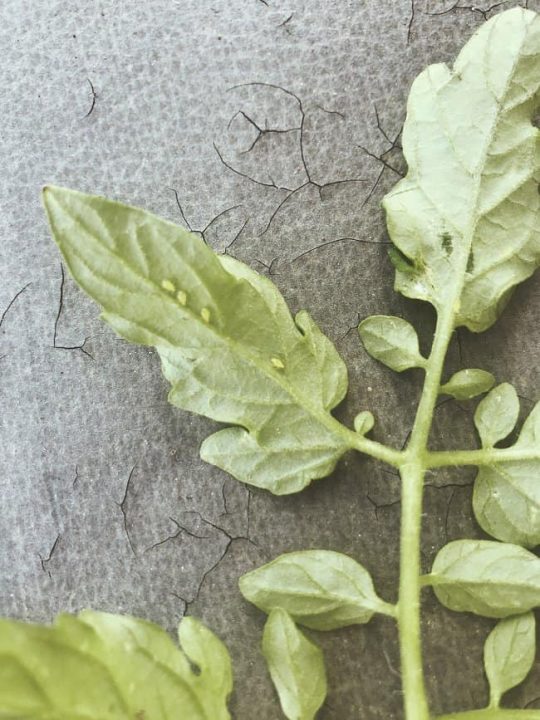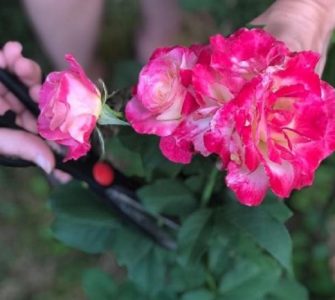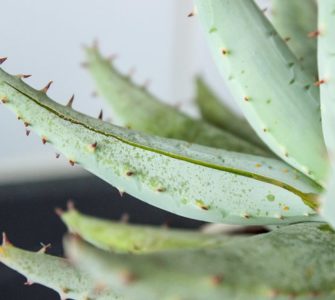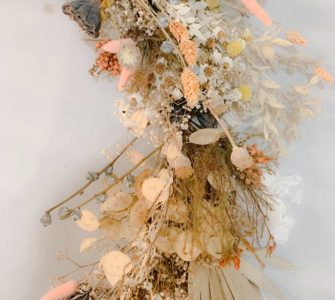How to Make an Aphid Spray at Home (step-by-step)!
Arrrghhh aphids are the bane of my life! You know that feeling when you suddenly spot that suspiciously curled up leaf, yellowing slightly too perhaps…
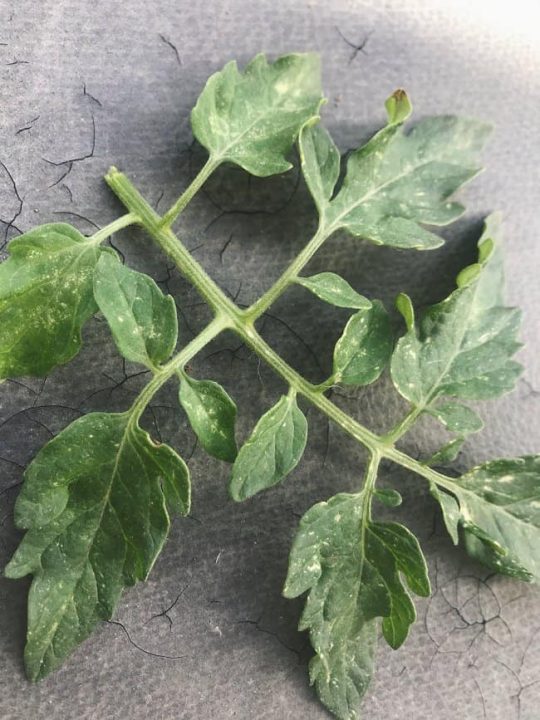
This is from my tomato plant, but the impact on a rose bush is the same! Curling leaves at the sides and flecks of yellow around the edges or on the leaves themselves.
You observe it underneath, and sure enough, there is a swarm of tiny dots lining the entire underside, and the other leaves seem affected too! Some are even spread out on the stem, and, ohhhh the dots are MOVING!
The first time I spotted aphids on my roses I was a little confused. In fact it was a wonder I spotted them at all, as they are relatively microscopic. So even if you can’t see yours, it doesn’t mean you haven’t got them, which makes them somehow even worse. Invisible invaders!
Are these little creatures bugs, are they pests at all, and how did this happen when I did everything right while planting and watering the rose? More importantly, what can and what should I do? Are they endangering my rose bush?
You didn’t do anything wrong! Aphid eggs are incredibly difficult to spot in the first place, and in case your rose plant is store-bought, it might be pre-contaminated with them. However, this is completely normal and expected, and getting rid of them is not a difficult feat.
I know my poor potted rose plant which was my first ever one, was infested within days of me bringing it home and I don’t have a huge garden – the invaders most likely came along with it.
What are aphids?
Aphids are a very common pest on ornamental plants, such as roses and orchids.
There are many different varieties that attack many different plants. Aphids are the most common rose pest by far, and the variety carries a Latin name of Macrosiphum rosae. They are tiny, soft-bodied, juice-sucking insects that love rosebuds.
Intolerant to heat, they will be most problematic during cold and damp weather conditions and especially throughout early to mid-spring.
The pests you spotted on your rose bush are likely all females, as males do not usually occur in the wild. Mature females spread during the summer by developing wings and easily infecting other plants in the vicinity, as well as laying eggs on rose bushes in autumn.
Table of Contents
Does my rose plant have aphids?
Aphids are usually easy to spot, and can come in a multitude of colours such as green, white, yellow or black. The ones that attack rose bushes are usually green and red. The colour and appearance vary greatly depending on the season and the climate of the area you live.
Prime spots for aphids are new and delicate growths and undersides of leaves – this is their favourite place to feed. Curled and discoloured leaves and shoots are the first signs of an infestation.
Inspect your rose plant thoroughly, and often, as aphid populations tend to have rapid and explosive growth in numbers.
What Do Aphids Look Like?
One thing you’ll rarely hear about aphids is that they come in multiple shapes, colours and sizes! Sometimes they look like tiny little red or brown moving dots, other times they’ll be the size and color of a tiny green seed.
It makes identifying them rather difficult but it’s safe to assume most organic garden bug repellents will work to get rid of them, whatever they look like!
My rose bush has aphids! What do I do?
If you have multiple rose plants and find that some are infected and some are not, you should separate them immediately, if it is physically possible to do so. A good thing to do is to “quarantine” the healthy plants as soon as you spot aphids. If your rose plants are indoors, move them to another room in your apartment, which will prevent the physical spread of winged aphids to healthy plants.
Aphids are more dangerous if your plant is younger and they will very rarely kill an adult plant. However, they can carry various plant diseases and are also prone to attracting ants.
Thankfully, these little critters are easy to combat with homemade solutions – no need for chemical pesticides here!
I made an amazing DIY rose bush aphid spray at home, with entirely organic solutions! And it lasts for at least a week, if not two! The aphids now leave my rose and tomato plants entirely alone.
Ready? Here’s what you’re going to need to make yours!
Shopping list
Here’s what you need to make your aphid spray at home!
- spray bottle (500 mL – 1L in volume capacity)
- organic soap (non-toxic) or organic natural liquid dish detergent
- 6 cloves garlic
- hot sauce (yes, you read that right)!
- vegetable or olive oil
- water
- soft cloth
- aphid traps (optional)
- ladybug sheets (optional)
- herbal honey (optional)
- orange peel (optional)
The DIY Aphid Spray For Roses Method!
- Grab a few slices of your organic soap. Just tiny slices will do, fingernail size. Add them to your mixing bottle. No soap? no matter! This DIY Aphid spray works just as well without it but soap does add that extra ‘stick’.
- Slice your garlic into thin slices. Add to bottle
- Drizzle in some olive oil. Three big generous drizzles.
- Add your tablespoon of hot sauce!
- Top up your spray bottle with hot (not boiling!) water.
- Put the top on your spray bottle and shake it all like a crazy person
- Like the mixture cool for ten minutes or so
Grab your bottle and spray your rose! Note – your rose probably isn’t going to like it, and every time I do it a few of my rose leaves yellow or fall off altogether in protest. You haven’t killed your rose bush, and it will totally recover – just give it two or three days to recover from it’s indignation at being sprayed! 🙂
Aphid sprays work in multiple ways. They penetrate the soft barrier of the body of the aphid and simply dry them out, eliminating them in the process.
They also prevent the aphids from gripping on to the rose and it’s parts, as the soap and oil make the surface too slippery for them to hold on to.
Finally, they hate garlic and chilli, which repels them from coming back and building their home on your leaves.
DIY Rose Aphid spray wins in so many ways, and because it’s all-organic, it doesn’t destroy your rose, harm the soil, or hurt any part of your garden eco-system!
TIP- once you’ve used all the spray, remove the garlic slices and add 1-3 in the soil about 15-20cm away from your rose plant. It keeps those bugs from invading your rose’s nearby space and climbing up the stems!
A Really Strong DIY Rose Aphid Spray
If your aphid infestation is really overwhelming the plant, and no other solution mentioned is working after 3-4 days of using it, a solution to be used as a last resort only is the one with medicinal alcohol in it.
Clean your spray bottle out of the previous solution. Fill about ⅓ of the bottle with medicinal alcohol (96%) and then fill up to the top with water. Add a few drops of organic soap or dish detergent. Mix well, close the bottle and shake well.
This solution might not be suitable for all rose plants. Before you go to town on the entire bush, be sure to patch-test first and spray only on one leaf affected by the pests.
Note – only use this if your rose looks like it’s truly on its last legs and dying off. Leaf curl needs to be severe. There is also a chance this spray could harm your rose plant so it’s only to be used as a last resort!
When To Use Your Aphid Spray At Home
Use the spray in the morning and in the evening to avoid sun burning the wet rose foliage. Spray the entire area of the rose plant, including the entire stem and the underside of the leaves copiously and don’t rinse. Let it sit as is for 24 hours.
After 24 hours pass, re-inspect your plant. Upon checking the underside of the leaves, you should see that the aphids have been neutralised. You will know that the spray worked if the aphids turn black from whatever colour they were originally and if you don’t notice any new colonies or spreading to the stem or other leaves.
At this point, before respraying the plant, you can gently remove the aphids manually if there are large clusters that have been neutralised. Take a soft cloth and wipe away the dead aphids off the underside of the leaves and the stem.
Spray the entire area of the rose plant once more and don’t rinse in order to get rid of all of the aphids. They can be tricky pests and tend to hide where you can’t spot them due to their tiny size and begin re-spreading after the solution dries up.
After the solution of your choice has worked its magic and you are no longer finding any live aphids on your rose bush, make sure to gently but copiously spray the rose with water. If the rose plant is smaller, wipe the water off to make sure the spray is rinsed off completely.
Using Ladybirds To Prevent Aphids On Your Rose Plant
In case you spot aphids, look out for beneficial insects such as ladybugs.
If you keep your infected rose plants on a balcony, you can battle bigger infections by controlled releases of ladybirds, which will feed on the aphids. Aphids are a favourite snack of choice for any ladybugs, and they will eat them like there is no tomorrow. You can purchase them in sheets at garden stores or online, but if you don’t have an open garden, be careful to release only a limited number of them so that you can safely remove them from the roses once they do their job. Make sure to regularly mist your roses with water, as ladybugs are very thirsty creatures and voracious eaters.
The coexistence of ladybugs and roses is beneficial in more than one way, as ladybug poop is a very good and nutritious soil fertilizer!
As stated earlier, aphids attract ants, as ants feed off of the aphid honeydew that aphids naturally produce. Ants will also fight off other beneficial insects, especially ladybugs, so it is imperative you get rid of them as soon as the infestation is spotted.
How To Prevent Aphids From Attacking Your Rose Plant
Using Basil To Prevent Aphid Attacks
In case you are also growing some basil for your pesto or tomato sauce needs, you can use the leaves to make a powerful preventive spray (deterrent) for your rose.
Add a bunch of basil leaves to 500 mL of water. Let it steep for a week at a dark and cold place.
After a week, remove and compost the basil leaves. Add 2 tablespoons of liquid dish detergent to the spray bottle and pour the basil tea inside over it. Mix well, close the bottle and shake well.
Alternative Methods To Prevent Aphid Attacks
Aphids are mostly attracted to lush, fresh and new growths and rosebuds.
Best method of prevention is to avoid over-fertilizing your plants. Use organic and balanced fertilizer and periodically test the acidity of the soil to make sure the conditions are met for your rose to thrive.
If you spot a limited and controlled infestation early on (for example, a lot of aphids on a small amount of leaves), simply prune the leaves off, provided your plant is mature enough.
Do Aphid Traps Work?
You can also invest in aphid traps. They can be acquired at garden stores or ordered online. They come as sticky sheets that are very bright green in colour. Attach them to your rose plant, and aphids will hurry to the trap as they are attracted by the bright green colour and stick onto it, after which you can simply remove and replace the trap with a fresh new sheet.
How To Use Honey To Prevent Aphids
Some gardeners swear by using honey as a prevention method. Rub a bit of herbal honey on the lower part of the stem to prevent aphids from climbing back up and spreading to the leaves.
Using Orange Peel To Prevent Aphids
Other gardeners swear by orange peel. Orange peel kills aphids, but ants are incredibly attracted to the smell of oranges and will flock in droves towards the small peel slice.
The next time you spot aphids on your roses, you won’t be alarmed, and you will know that you have all your artillery already stocked in your pantry – and believe me, no store-bought, chemical-laden spray will work better than an organic solution you can make yourself.
Enjoy your Aphid-free roses! 🙂
If you found this post useful, we’d love to know! Please do leave us a comment below if you go ahead and make your own DIY aphid spray 🙂
